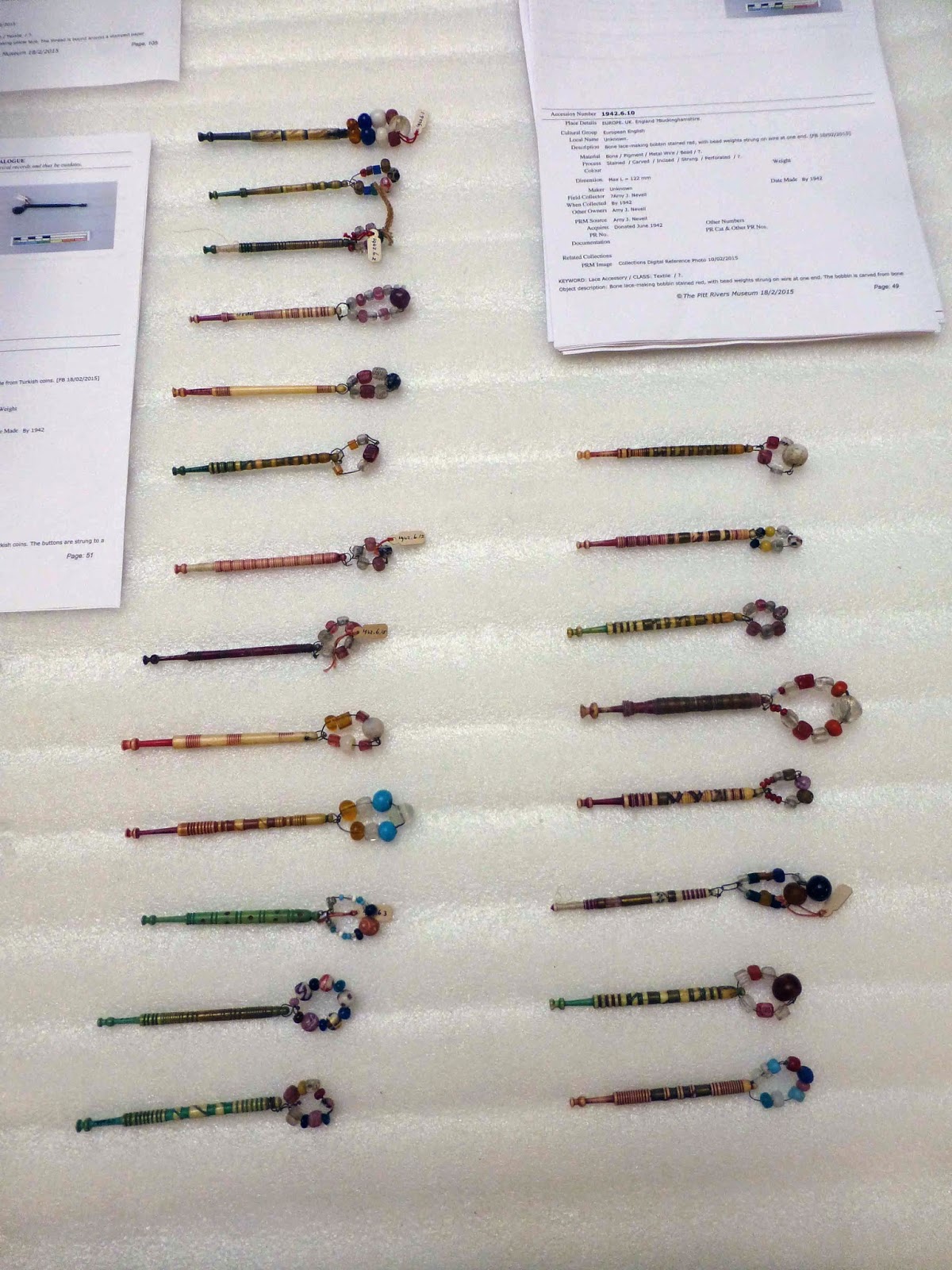On the 20th of February I welcomed a research visit from
Nicolette Macovicky, Russian and East European Studies and
David Hopkin, Faculty of History. They came to look at
lace and lace related objects in the Pitt Rivers collections. Many people visiting the museum would assume that the collections whilst global are not local, they would be mistaken, much of the lace related material in the collections is from Oxfordshire and neighbouring counties. To highlight the more local objects in the collections, some of the objects retrieved for Nicolette and David's visit featured in the 2006-2009 ESRC-funded research project
'England: The Other Within: Analysing the English Collections at the Pitt Rivers Museum'
The Pitt Rivers Museum are a partner in Nicolette and David's
HEIF Heritage Knowledge Exchange funded project
'By the Poor, For the Rich: Lace in context. Bridging the gaps between archives, textiles and social history collections'. Other project partners include the
Museum of English Rural Life and
The Lace Guild. Both having expertise in social and historical contexts of lace and lace making it was very interesting for me to hear what Nicolette and David thought of the selection of objects they looked at on their visit.
 |
| Bobbin winder as reconstructed by conservation; 1911.29.17. © Pitt Rivers Museum |

Included in the selection were lace making tools such as this bobbin winder (
1911.29.17), collected by folklorist and antiquarian
Percy Manning. Manning spent most of his adult life collecting objects from Oxfordshire. This bobbin winder is from
Launton, an Oxfordshire village on the eastern outskirts of
Bicester. The bobbin winder itself was in poor condition and needed some remedial conservation work involving reconstructing the bobbin winder to figure out how it would have worked. The bobbin winder is a practical object and is very simple in design, compared with another example we have on display which is made from pieces of turned wood, this bobbin winder is rudimental in comparison but does exactly the same job. Inscribed on the bobbin winder is
'Machine for winding thread on to a bobbin used in lace making bought of Maria Woods of Launton, Oxon, 1894.'. Using information from the
census, David hopes to be able to track down Maria Woods of Launton and find out more about her.

Also collected by Manning are the
dick pot (1911.29.45), lace makers candle stand (1911.29.22) and horse (1911.29.20 .1). The
'horse' was used to rest the lace pillow on whilst working. Nicolette thought that the low height of this particular horse indicated that it could have been used by children or for teaching lace making. Adequate lighting was important in lace making, the
candle stand was used to concentrate the light from a single candle and focus it on the lace pillow. Finally, the
dick pot would have been used for hot embers, the lace makers would place the pot under their skirts to keep themselves warm. It is surprising that the dick pot does not have a lid and the dangers of catching fire to the voluminous skirts would have been likely. Sitting near a fire was not an option for fear of the smoke dirtying the lace thread with which they were working. Again, David is going to further research this by looking through old newspaper archives fro reports of accidents and fires involving lace makers.
 |
| Lace making display in court, C.115.A © Pitt Rivers Museum |
Of all the lace making material we have, the majority of the collection consists of beautifully made
bobbins. There are
bobbins made from both bone and wood, the bone ones being unique to the UK. The aesthetic around lace making is best illustrated by the lovingly crafted bobbins, often given as keepsakes and love tokens. They are weighted with glass beads which may have been traded from the continent. The square beads with impressed lines, made using a file, were made specifically for the bobbins to provide grip and prevent the bobbin from slipping when in place.
I look forward to seeing how the project progresses and hearing back from Nicollete and David once they have followed up some of the leads and done some further research. If you are interested in lace making, there is a
display in the Museum Court, case 115.A, with a large number of bobbins and lace making material.
Faye Belsey
Assistant Curator


























